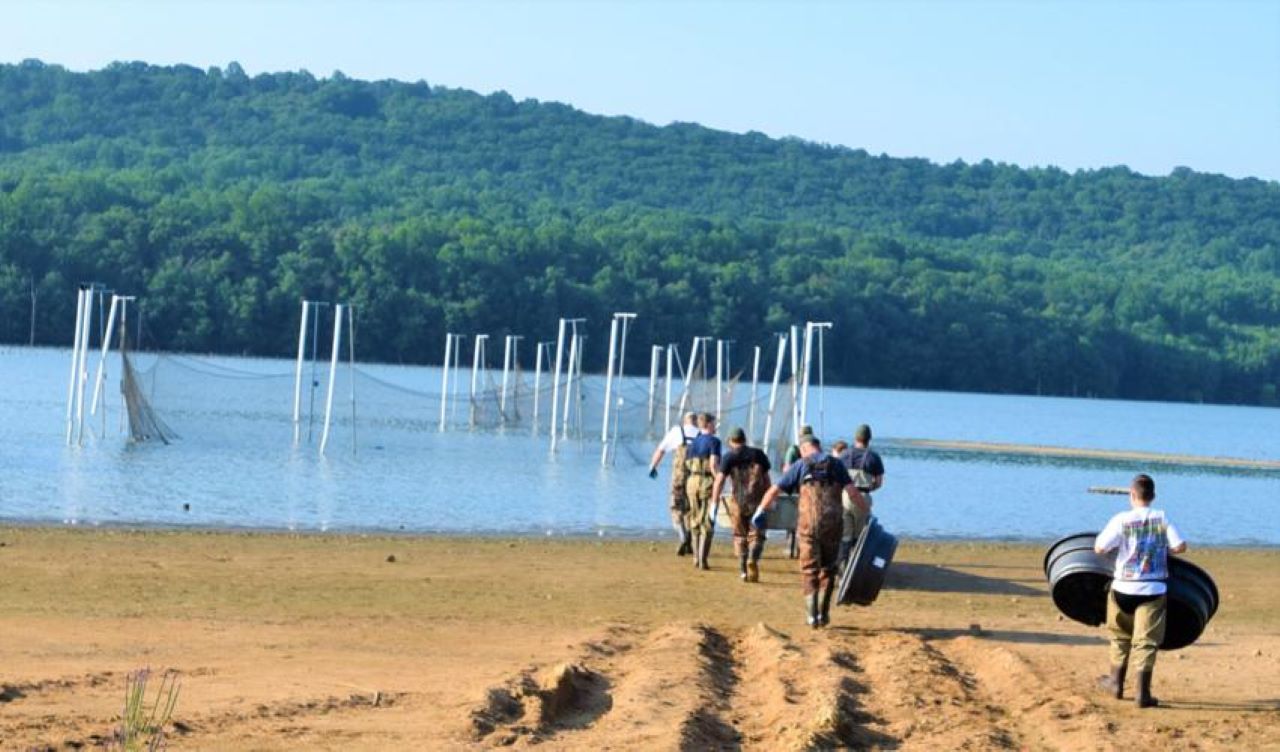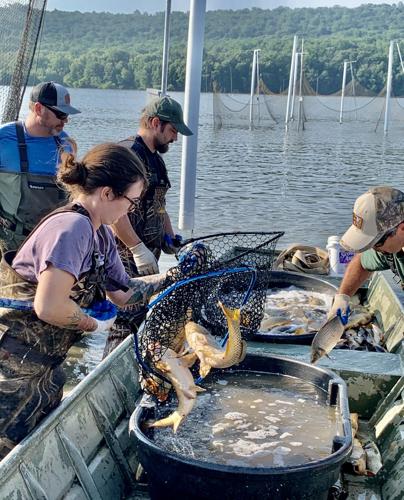
A Pennsylvania Game Commission crew hauls a boat to nets in Middle Creek Lake to capture and remove invasive carp.
Ad Crable / LNP | LancasterOnline

A Pennsylvania Game Commission crew hauls a boat to nets in Middle Creek Lake to capture and remove invasive carp.
Ad Crable / LNP | LancasterOnline

Ad Crable / LNP | LancasterOnline
A Pennsylvania Game Commission crew hauls a boat to nets in Middle Creek Lake to capture and remove invasive carp.
This story is published in partnership with our sister newsroom LNP | LancasterOnline. For more coverage, click here.
Thousands of non-native, invasive carp have taken over Middle Creek Lake. They are being evicted to help migratory waterfowl and other gamefish at Middle Creek Wildlife Management Area in northern Lancaster County.
In five weekly trappings so far this summer by the Pennsylvania Game Commission, special nets baited with cracked corn in lake shallows have already captured more than 1,600 carp 12-18 inches long.
The common carp, along with some mirror carp, are euthanized on the spot in tubs of water, isopropyl alcohol and clove oil, then taken to a local farmer who composts them and spreads the remains as fertilizer on crop fields.
No one is sure how the carp got established in the 360-acre lake since it was built as part of the wildlife area in the early 1970s. The Pennsylvania Fish and Boat Commission stocked largemouth bass, channel catfish, bluegills, crappie and yellow perch but not the undesirable carp. Perhaps anglers released the fish or birds of prey dropped one here or there flying over the lake.
What is certain is the out-of-control carp have exploded in numbers to the point they are damaging the lake’s water quality, as well as desirable gamefish and waterfowl that flock to Middle Creek in the spring and fall to rest and refuel on long migrations.

Ad Crable / LNP | LancasterOnline
Crews place capture nonnative carp into tubs of euthanasia solution to kill them at the lake at Middle Creek Wildlife Management Area.
The Game Commission is in the midst of a large-scale project to establish shoreline vegetation in the lake and two dozen wetlands. The plants drop seeds when immersed for waterfowl. But in the lake, carp quickly graze on the emerging plants, destroying the food sources.
The carp also excrete large amounts of the nutrient phosphorus, which can cause algae blooms that suck oxygen out of the lake. Carp’s habit of feeding in the shallows of the lake results in the nests of gamefish being destroyed and eggs eaten. Their roving in the shallows stirs up clouds of sediment, hurting water clarity.
“These are not meant to be fish ponds. They are for waterfowl,” says Steve Ferreri, the Game Commission’s regional land management supervisor, of Middle Creek’s mission. “And we want diversity in fish not a monoculture.”
Few anglers come to Middle Creek to fish specifically for carp and Game Commission crews take time to explain to visiting fishers that the carp thinning will help channel catfish and other preferred gamefish, says Alex Murray, regional land management group supervisor.
“We definitely have the structure under the water line but it’s just all these carp disturbing the nesting,” he says.
About a dozen Game Commission crew members and volunteers gathered on a recent morning off a point of the lake. They hauled a johnboat filled with tubs of the euthanasia solution to the first of two 30-by-60-foot nets anchored by stakes rising from the shallow water. The nets had been filled with corn several days earlier to entice the carp, which were clustered in the drawn-down lake’s shallows to spawn.
Lifting the sides of the net quickly concentrated a seething mass of carp. The crews took turns dipping nets of fish. Channel catfish went back in the lake. The two species of carp were dumped into the euthanasia solution and quickly died.
Two surprise guests included a large snapping turtle and a mouse stowaway that skittered over the bellies of the carp in the boat and leaped into the lake. It was rescued by a youth, Tannis Hudock, and carried safely back to terra firma.
After about an hour, the boat was overflowing with carp — 441 to be exact and by far the largest haul of the trapping project so far. The boat, containing somewhere between 1,300 and 2,200 pounds of carp bodies, was so heavy a backhoe and tow strap had to be deployed to get it onshore.
This culling operation will continue until mid-September and again next summer. Murray is confident the netting will get the carp population down to a manageable level. If not, more extreme measures would be considered, such as draining the lake, moving gamefish and amphibians to a temporary storage waterway, removing all carp, then restocking the fish.

Sometimes, your mornings are just too busy to catch the news beyond a headline or two. Don’t worry. The Morning Agenda has got your back. Each weekday morning, host Tim Lambert will keep you informed, amused, enlightened and up-to-date on what’s happening in central Pennsylvania and the rest of this great commonwealth.
The days of journalism’s one-way street of simply producing stories for the public have long been over. Now, it’s time to find better ways to interact with you and ensure we meet your high standards of what a credible media organization should be.